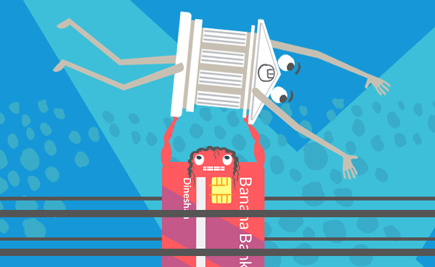
What is “Balance Transfer” on Credit Card?
Let us assume that Mr. A has multiple Credit Cards and he hasn’t been making timely repayments of his Credit Card debt every month. Due to this, he has to pay heavy interest at the rate of 3.5% per month (42% per annum) on the balance outstanding against his card.
Eventually, he finds it difficult to manage the dues on his cards, which further pile up month on month creating a large amount of debt. In this situation, Mr. A should consider going in for a balance transfer facility with another Credit Card provider.
In short, a balance transfer means switching your Credit Card outstanding balance or dues to (typically) a new Credit Card. In other words, you can apply for a new Credit Card with a balance transfer option wherein your new card company will pay all your previous dues to the old Credit Card Company.
Not only this, the new card company may also offer you a lower rate of interest on the outstanding balance as well as other benefits like an interest free period, fixed interest rate for first 3 months or maybe even more reward points, depending on their internal guidelines.
Additional Reading: Myths About Credit Card Rewards
How does a balance transfer work?
If you decide to go for a balance transfer, then, with very little documentation, you can easily get your balance transferred to the new Credit Card within 5-7 working days. Here, the new Credit Card company issues a cheque/DD or makes an online payment to the old Credit Card company.
Additional Reading: Top 6 Balance Transfer Credit Cards In India
Points to remember before you make the switch
It is very important to understand the terms and conditions of a balance transfer before you switch. We recommend watching out for the following clauses before switching over to a new Credit Card for a balance transfer:
- Many Credit Card companies offer 0% APR (Annual Percentage Rate) on the balance transfer amount for the first few months. However, they do not provide any interest free/ grace period for any fresh purchases made on the Credit Card. The borrower has be very cautious with this type of condition. In this case, we advise the borrower to use the new card purely for debt repayment and try not to use the card for any fresh purchases.
- The Credit Card company might offer a rate of interest as low as 0% for the first few months, but they might charge you with a very high processing fee. The borrower should be watchful about cards with low interest and high processing fee and must check whether switching over is really profitable or not.
- The borrower should also verify the APR after the end of the promotional offer. Some Credit Card companies offer lower APR in the initial 2-3 months, but might charge a very high rate later.And this rate can even be higher than your existing card. If this is the scenario, then the borrower has to be vigilant as he or she might end up repaying more interest in the long run.
- Before finalising the balance transfer, the borrower should check the minimum and maximum amount of the balance transfer allowed by new card company. Generally, the card companies allow a minimum transfer of Rs. 2,500 and a maximum of up to 75% of your credit limit with your existing card company.
Additional Reading: Balance Transfer Between Credit Cards: Things To Consider
Understand the concept with an example
Let us assume that Mr. A regularly repays his Credit Card bill/ dues without delay. But this time, his Credit Card bill went up to Rs. 1 lakh, which he is finding difficult to repay by the due date.
He is worried that if he doesn’t pay his complete Credit Card bill amount by the due date, his Credit Card company will charge him a heavy Annual Percentage Rate (say at 3.5% per month) from the day he made his purchases.
Now, one option is to repay the complete amount with a heavy ROI or get his Credit Card balance transferred to another card issuer that is offering lucrative promotional offers.
Let us look into all the options in detail and see which one will suit Mr. A:
Outstanding Bill Amount: Rs.1,00,000/-
Existing APR (Annual Percentage Rate): 3.5% per month
Let us assume that interest is charged on the basis of simple interest calculation
Interest amount to be paid for 30 days =Rs.3,500
Promotional offer provided by new card issuer:
| Plans Available | Processing Fees |
| Plan A – 0% per month for 2 months | 2% or Rs. 199, whichever is higher |
| Plan B – 1.7% per month for 6 months | No processing fees |
Considering all of the above, Mr. A has 3 options:
| Option I | Stay with his existing Credit Card and repay ROI at 3.5% per month |
| Option II | Balance transfer with Plan A (0% per month & 2% processing fee) |
| Option III | Balance Transfer with Plan B (1.7% per month with zero processing fee) |
Now, before deciding on any option, Mr. A has to first analyse his future plan of repayment i.e. how much time he needs to repay his existing debt of Rs. 1,00,000. The time period taken to repay the debt is key for deciding the right option.
Additional Reading: Shred Those Credit Card Debts To Nothing!
Calculation for debt repayment in two different time periods of 2 months and 6 months
Repay debt in 2 months:
Option I: If he stays with the existing Credit Card, and takes 2 months to repay Rs.1,00,000, then he might have to pay an additional Rs. 7,000 as interest to the Credit Card company (APR=3.5% pm).
Option II: He can get his balance transferred and only pay a processing fee of 2% i.e. Rs.2,000/- and no interest (please refer Plan A with 2% Processing Fee)
Option III: If he opts for Plan B, and agrees to repay 1.7% per month as interest, then he will have to pay Rs. 3,400/- as interest amount to the lender (for 2 months).
So, in this case wherein Mr. A has short-term plan of 2 months to make repayment, we suggest him to opt for Balance Transfer with Plan A (0% pm for 2 months)
Repay Debt in 6 months:
Option I: Mr. A has to repay Rs. 21,000 as interest to the bank (at 3.5% pm and 21% APR for 6 months)
Option II: Mr. A has to repay 0% for first 2 months and 3.5% each month for next 4 months. He will end up paying Rs. 14,000 as interest and Rs. 2,000 as processing fee i.e. Rs. 16,000 in total.
Option III: He has to pay @1.7% pm i.e. Rs. 10,200 for 6 months as interest.
In this case, the most cost effective is Plan B.
From the above illustrations, it can be concluded that going for a balance transfer can be a better option provided all the terms and conditions are acceptable to you.
Balance transfers are good, but if you’re diligent with your repayment then you don’t have to worry about all these calculations. Defaulting your Credit Card payments can affect your Credit Score too.
Additional Reading: Terrific Ways To Build Your Credit Score
Check your Experian Credit Score for FREE by clicking on this link! |
And if your score is green, then you can definitely think about getting a Credit Card.
